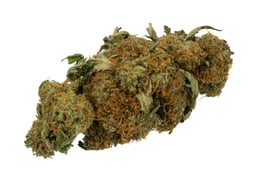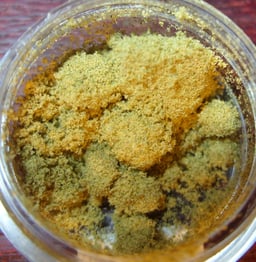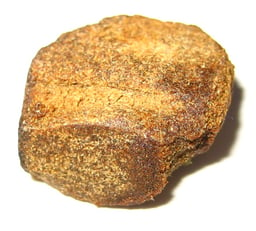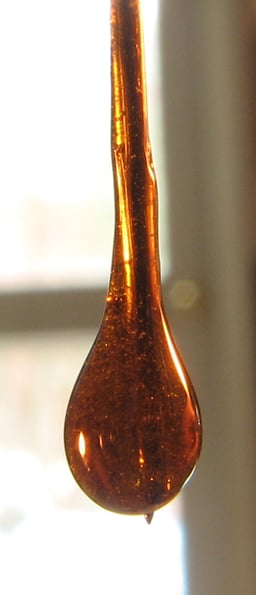Cannabis
-EXk1KXEE7CUTr0y9mQD8n9ypIdLvxt)
Cannabis
-EXk1KXEE7CUTr0y9mQD8n9ypIdLvxt)
| Cannabis | |
|---|---|
| Product name | Cannabis |
| Pronunciation | |
| Source plant(s) | Cannabis sativa,Cannabis indica,Cannabis ruderalis |
| Part(s) of plant | Flowerandfruit |
| Geographic origin | Central AsiaandIndian subcontinent[6] |
| Active ingredients | Tetrahydrocannabinol,cannabidiol,cannabinol,tetrahydrocannabivarin |
| Main producers | Afghanistan,[7]Canada,[8]China, Colombia,[9]India,[7]Jamaica,[7]Lebanon,[10]Mexico,[11]Morocco,[7]Netherlands, Pakistan, Paraguay,[11]Spain,[7]Thailand, Turkey, United States[7] |
| Legal status | |
Cannabis has mental and physical effects, such as creating a "high" or "stoned" feeling, a general change in perception, heightened mood, and an increase in appetite.[26][27] Onset of effects is felt within minutes when smoked, and about 30 to 60 minutes when cooked and eaten.[26][28] The effects last for two to six hours.[28] Short-term side effects may include a decrease in short-term memory, dry mouth, impaired motor skills, red eyes, and feelings of paranoia or anxiety.[26][29][30] Long-term side effects may include addiction, decreased mental ability in those who started regular use as teenagers, and behavioral problems in children whose mothers used cannabis during pregnancy.[26] There is a strong relation between cannabis use and the risk of psychosis,[31] though the cause-and-effect is debated.[32]
Cannabis is mostly used for recreation or as a medicinal drug, although it may also be used for spiritual purposes. In 2013, between 128 and 232 million people used cannabis (2.7% to 4.9% of the global population between the ages of 15 and 65).[33] It is the most commonly used illegal drug both in the world and the United States,[26][33] though it is also legal in some jurisdictions. The countries with the highest use among adults as of 2018 are Zambia, the United States, Canada, and Nigeria.[34] In 2016, 51% of people in the United States had used cannabis in their lifetimes.[35] About 12% had used it in the past year, and 7.3% had used it in the past month.[36]
While cannabis plants have been grown since at least the 3rd millennium BCE,[37] evidence suggests it was being smoked for psychoactive effects at least 2,500 years ago in the Pamir Mountains.[38] Since the early 20th century, cannabis has been subject to legal restrictions. The possession, use, and cultivation of cannabis is illegal in most countries of the world.[39][40] In 2013, Uruguay became the first country to legalize recreational use of cannabis.[41] Other countries to do so are Canada, Georgia, and South Africa, plus 11 states and the District of Columbia in the United States (though the drug remains federally illegal).[41][42] Medical use of cannabis, requiring the approval of a physician, has been legalized in a greater number of countries.[43]
| Cannabis | |
|---|---|
| Product name | Cannabis |
| Pronunciation | |
| Source plant(s) | Cannabis sativa,Cannabis indica,Cannabis ruderalis |
| Part(s) of plant | Flowerandfruit |
| Geographic origin | Central AsiaandIndian subcontinent[6] |
| Active ingredients | Tetrahydrocannabinol,cannabidiol,cannabinol,tetrahydrocannabivarin |
| Main producers | Afghanistan,[7]Canada,[8]China, Colombia,[9]India,[7]Jamaica,[7]Lebanon,[10]Mexico,[11]Morocco,[7]Netherlands, Pakistan, Paraguay,[11]Spain,[7]Thailand, Turkey, United States[7] |
| Legal status | |
Uses
Medical

Main short-term physical effects of cannabis
Medical cannabis, or medical marijuana, can refer to the use of cannabis and its cannabinoids to treat disease or improve symptoms; however, there is no single agreed-upon definition.[44][45] The rigorous scientific study of cannabis as a medicine has been hampered by production restrictions and by the fact it's classified as an illegal drug by the many governments.[46] There is limited evidence suggesting cannabis can be used to reduce nausea and vomiting during chemotherapy, to improve appetite in people with HIV/AIDS, or to treat chronic pain and muscle spasms.[47][48][49] Its use for other medical applications is insufficient for drawing conclusions about safety or efficacy.
Short-term use increases the risk of both minor and major adverse effects.[48] Common side effects include dizziness, feeling tired and vomiting.[48] The long-term effects of cannabis are not clear.[48] There are concerns surrounding memory and cognition problems, risk of addiction, schizophrenia in young people, and the risk of children taking it by accident.[47]
Recreational
Cannabis has psychoactive and physiological effects when consumed.[50] The immediate desired effects from consuming cannabis include relaxation and euphoria (the "high" or "stoned" feeling), a general alteration of conscious perception, increased awareness of sensation, increased libido[51] and distortions in the perception of time and space. At higher doses, effects can include altered body image, auditory and/or visual illusions, pseudohallucinations and ataxia from selective impairment of polysynaptic reflexes. In some cases, cannabis can lead to dissociative states such as depersonalization[52][53] and derealization.[54]
Some immediate undesired side effects include a decrease in short-term memory, dry mouth, impaired motor skills and reddening of the eyes.[55] Aside from a subjective change in perception and mood, the most common short-term physical and neurological effects include increased heart rate, increased appetite and consumption of food, lowered blood pressure, impairment of short-term and working memory,[56][57] psychomotor coordination, and concentration. Some users may experience an episode of acute psychosis, which usually abates after six hours, but in rare instances, heavy users may find the symptoms continuing for many days.[58]
A reduced quality of life is associated with heavy cannabis use, although the relationship is inconsistent and weaker than for tobacco and other substances.[59] The direction of cause and effect relationship, however, is unclear.[59]
Spiritual
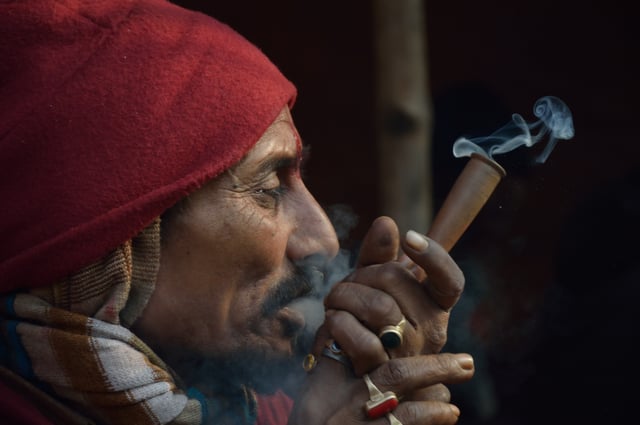
A man smoking cannabis
Cannabis has held sacred status in several religions and has served as an entheogen – a chemical substance used in religious, shamanic, or spiritual contexts[60] – in the Indian subcontinent since the Vedic period dating back to approximately 1500 BCE, but perhaps as far back as 2000 BCE. There are several references in Greek mythology to a powerful drug that eliminated anguish and sorrow. Herodotus wrote about early ceremonial practices by the Scythians, thought to have occurred from the 5th to 2nd century BCE. In modern culture, the spiritual use of cannabis has been spread by the disciples of the Rastafari movement who use cannabis as a sacrament and as an aid to meditation. The earliest known reports regarding the sacred status of cannabis in the Indian subcontinent come from the Atharva Veda, estimated to have been written sometime around 2000–1400 BCE.[61]
Available forms
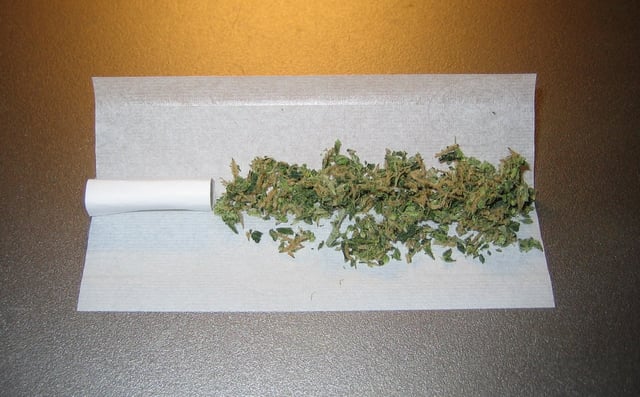
A joint prior to rolling, with a paper handmade filter on the left
Cannabis is consumed in many different ways:[62]
smoking, which typically involves burning and inhaling vaporized cannabinoids ("smoke") from small pipes, bongs (portable versions of hookahs with a water chamber), paper-wrapped joints or tobacco-leaf-wrapped blunts, and other items.[63]
vaporizer, which heats any form of cannabis to 165–190 °C (329–374 °F),[64] causing the active ingredients to evaporate into vapor without burning the plant material (the boiling point of THC is 157 °C (315 °F) at atmospheric pressure).[65]
cannabis tea, which contains relatively small concentrations of THC because THC is an oil (lipophilic) and is only slightly water-soluble (with a solubility of 2.8 mg per liter).[66] Cannabis tea is made by first adding a saturated fat to hot water (e.g. cream or any milk except skim) with a small amount of cannabis.[67]
edibles, where cannabis is added as an ingredient to one of a variety of foods, including butter and baked goods. In India it is commonly made into a beverage, bhang.
capsules, typically containing cannabis oil, and other dietary supplement products, for which some 220 were approved in Canada in 2018.[68]
Adverse effects
Short term
Acute effects may include anxiety and panic, impaired attention and memory, an increased risk of psychotic symptoms, [2] the inability to think clearly, and an increased risk of accidents.[71][72][73] Cannabis impairs a person's driving ability, and THC was the illicit drug most frequently found in the blood of drivers who have been involved in vehicle crashes. Those with THC in their system were from three to seven times more likely to be the cause of the accident than those who had not used either cannabis or alcohol, although its role is not necessarily causal because THC stays in the bloodstream for days to weeks after intoxication.[74][75][3]
According to the United States Department of Health and Human Services, there were 455,000 emergency room visits associated with cannabis use in 2011.
These statistics include visits in which the patient was treated for a condition induced by or related to recent cannabis use.
The drug use must be "implicated" in the emergency department visit, but does not need to be the direct cause of the visit.
Most of the illicit drug emergency room visits involved multiple drugs.[78] In 129,000 cases, cannabis was the only implicated drug.[79][80]
Long term
Heavy, long-term exposure to marijuana may have biologically based physical, mental, behavioral and social health consequences and may be "associated with diseases of the liver (particularly with co-existing hepatitis C), lungs, heart, and vasculature".[85] It is recommended that cannabis use be stopped before and during pregnancy as it can result in negative outcomes for both the mother and baby.[86][87] However, maternal use of marijuana during pregnancy does not appear to be associated with low birth weight or early delivery after controlling for tobacco use and other confounding factors.[88] A 2014 review found that while cannabis use may be less harmful than alcohol use, the recommendation to substitute it for problematic drinking was premature without further study.[89] Various surveys conducted between 2015 and 2019 found that many users of cannabis substitute it for prescription drugs (including opioids), alcohol, and tobacco; most of those who used it in place of alcohol or tobacco either reduced or stopped their intake of the latter substances.[90]
A limited number of studies have examined the effects of cannabis smoking on the respiratory system.[91] Chronic heavy marijuana smoking is associated with coughing, production of sputum, wheezing, and other symptoms of chronic bronchitis.[71] The available evidence does not support a causal relationship between cannabis use and chronic obstructive pulmonary disease.[92] Short-term use of cannabis is associated with bronchodilation.[93] Other side effects of cannabis use include cannabinoid hyperemesis syndrome.[94]
Cannabis smoke contains thousands of organic and inorganic chemical compounds.
This tar is chemically similar to that found in tobacco smoke,[95] and over fifty known carcinogens have been identified in cannabis smoke,[96] including; nitrosamines, reactive aldehydes, and polycylic hydrocarbons, including benz[a]pyrene.[97] Cannabis smoke is also inhaled more deeply than tobacco smoke.[98] As of 2015, there is no consensus regarding whether cannabis smoking is associated with an increased risk of cancer.[99] Light and moderate use of cannabis is not believed to increase risk of lung or upper airway cancer. Evidence for causing these cancers is mixed concerning heavy, long-term use. In general there are far lower risks of pulmonary complications for regular cannabis smokers when compared with those of tobacco.[100] A 2015 review found an association between cannabis use and the development of testicular germ cell tumors (TGCTs), particularly non-seminoma TGCTs.[101] A 2015 analysis of six studies found little evidence that long-term or regular cannabis smoking was associated with lung cancer risk, though it could not rule out whether an association with heavy smoking exists.[102] Another 2015 meta-analysis found no association between lifetime cannabis use and risk of head or neck cancer.[103] Combustion products are not present when using a vaporizer, consuming THC in pill form, or consuming cannabis foods.[104]
There is concern that cannabis may contribute to cardiovascular disease,[105] but as of 2018, evidence of this relationship was unclear.[106][107] Cannabis is believed to be an aggravating factor in rare cases of arteritis, a serious condition that leads to amputation in some cases. Because 97% of subjects in the case-reports also smoked tobacco, a formal association with cannabis could not be made. If cannabis arteritis turns out to be a distinct clinical entity, it might be the consequence of vasoconstrictor activity observed from delta-8-THC and delta-9-THC.[108] Other serious cardiovascular events including myocardial infarction, stroke,[109] sudden cardiac death, and cardiomyopathy have been reported to be temporally associated with cannabis use. Research in these events is complicated because cannabis is often used in conjunction with tobacco, and drugs such as alcohol and cocaine.[110] These putative effects can be taken in context of a wide range of cardiovascular phenomena regulated by the endocannabinoid system and an overall role of cannabis in causing decreased peripheral resistance and increased cardiac output, which potentially could pose a threat to those with cardiovascular disease.[111] There is some evidence from case reports that cannabis use may provoke fatal cardiovascular events in young people who have not been diagnosed with cardiovascular disease.[112] Smoking cannabis has also been shown to increase the risk of myocardial infarction by 4.8 times for the 60 minutes after consumption.[113]
Neuroimaging
Although global abnormalities in white matter and grey matter are not associated with cannabis abuse, reduced hippocampal volume is consistently found. Amygdalar abnormalities are sometimes reported, although findings are inconsistent.[114][115][116] Preliminary evidence suggests that this effect is largely mediated by THC, and that CBD may even have a protective effect.[117]
Cannabis use is associated with increased recruitment of task-related areas, such as the dorsolateral prefrontal cortex, which is thought to reflect compensatory activity due to reduced processing efficiency.[116][115][118] Cannabis use is also associated with downregulation of CB1 receptors. The magnitude of down regulation is associated with cumulative cannabis exposure, and is reversed after one month of abstinence.[119][120][121] There is limited evidence that chronic cannabis use can reduce levels of glutamate metabolites in the human brain.[122]
Cognition
A 2015 meta analysis found that, although a longer period of abstinence was associated with smaller magnitudes of impairment, both retrospective and prospective memory were impaired in cannabis users.
The authors concluded that some, but not all, of the deficits associated with cannabis use were reversible.[123] A 2012 meta analysis found that deficits in most domains of cognition persisted beyond the acute period of intoxication, but was not evident in studies where subjects were abstinent for more than 25 days.[124] Few high quality studies have been performed on the long-term effects of cannabis on cognition, and results were generally inconsistent.[125] Furthermore, effect sizes of significant findings were generally small.[124] One review concluded that, although most cognitive faculties were unimpaired by cannabis use, residual deficits occurred in executive functions.[126] Impairments in executive functioning are most consistently found in older populations, which may reflect heavier cannabis exposure, or developmental effects associated with adolescent cannabis use.[127] One review found three prospective cohort studies that examined the relationship between self reported cannabis use and intelligence quotient (IQ). The study following the largest number of heavy cannabis users reported that IQ declined between ages 7–13 and age 38. Poorer school performance and increased incidence of leaving school early were both associated with cannabis use, although a causal relationship was not established.[119] Cannabis users demonstrated increased activity in task-related brain regions, consistent with reduced processing efficiency.[128]
Psychiatric
At an epidemiological level, a dose–response relationship exists between cannabis use and increased risk of psychosis[129][130][131] and earlier onset of psychosis.[132] Although the epidemiological association is robust, evidence to prove a causal relationship is lacking.[133] But a biological causal pathway is plausible, especially if there is a genetic predisposition to mental illness, in which case cannabis may be a trigger.[134]
It is not clear whether cannabis use affects the rate of suicide.[135][136] Cannabis may also increase the risk of depression, but insufficient research has been performed to draw a conclusion.[137][130] Cannabis use is associated with increased risk of anxiety disorders, although causality has not been established.[138]
A February 2019 review found that cannabis use during adolescence was associated with an increased risk of developing depression and suicidal behavior later in life, while finding no effect on anxiety.[139]
Reinforcement disorders
About 9% of those who experiment with marijuana eventually become dependent according to DSM-IV (1994) criteria.[80] A 2013 review estimates daily use is associated with a 10-20% rate of dependence.[47] The highest risk of cannabis dependence is found in those with a history of poor academic achievement, deviant behavior in childhood and adolescence, rebelliousness, poor parental relationships, or a parental history of drug and alcohol problems.[140] Of daily users, about 50% experience withdrawal upon cessation of use (i.e. are dependent), characterized by sleep problems, irritability, dysphoria, and craving.[119] Cannabis withdrawal is less severe than withdrawal from alcohol.[89]
According to DSM-V criteria, 9% of those who are exposed to cannabis develop cannabis use disorder, compared to 20% for cocaine, 23% for alcohol and 68% for nicotine. Cannabis abuse disorder in the DSM-V involves a combination of DSM-IV criteria for cannabis abuse and dependence, plus the addition of craving, minus the criterion related to legal troubles.[119]
Overdose
THC, the principal psychoactive constituent of the cannabis plant, has low toxicity. The dose of THC needed to kill 50% of tested rodents is extremely high. Cannabis has not been reported to cause fatal overdose in humans.[135]
Pharmacology
Mechanism of action
The high lipid-solubility of cannabinoids results in their persisting in the body for long periods of time.[142] Even after a single administration of THC, detectable levels of THC can be found in the body for weeks or longer (depending on the amount administered and the sensitivity of the assessment method).[142] A number of investigators have suggested that this is an important factor in marijuana's effects, perhaps because cannabinoids may accumulate in the body, particularly in the lipid membranes of neurons.[143]
Not until the end of the 20th century was the specific mechanism of action of THC at the neuronal level studied.
Researchers have subsequently confirmed that THC exerts its most prominent effects via its actions on two types of cannabinoid receptors, the CB1 receptor and the CB2 receptor, both of which are G protein-coupled receptors.[144] The CB1 receptor is found primarily in the brain as well as in some peripheral tissues, and the CB2 receptor is found primarily in peripheral tissues, but is also expressed in neuroglial cells.[145] THC appears to alter mood and cognition through its agonist actions on the CB1 receptors, which inhibit a secondary messenger system (adenylate cyclase) in a dose-dependent manner. These actions can be blocked by the selective CB1 receptor antagonist rimonabant (SR141716), which has been shown in clinical trials to be an effective treatment for smoking cessation, weight loss, and as a means of controlling or reducing metabolic syndrome risk factors.[146] However, due to the dysphoric effect of CB1 receptor antagonists, this drug is often discontinued due to these side effects.[147]
Via CB1 receptor activation, THC indirectly increases dopamine release and produces psychotropic effects.[148] Cannabidiol (CBD) also acts as an allosteric modulator of the μ- and δ-opioid receptors.[149] THC also potentiates the effects of the glycine receptors.[150] It is unknown if or how these actions contribute to the effects of cannabis.[151]
Chemistry
Detection in body fluids
THC and its major (inactive) metabolite, THC-COOH, can be measured in blood, urine, hair, oral fluid or sweat using chromatographic techniques as part of a drug use testing program or a forensic investigation of a traffic or other criminal offense.[58] The concentrations obtained from such analyses can often be helpful in distinguishing active use from passive exposure, elapsed time since use, and extent or duration of use. These tests cannot, however, distinguish authorized cannabis smoking for medical purposes from unauthorized recreational smoking.[152] Commercial cannabinoid immunoassays, often employed as the initial screening method when testing physiological specimens for marijuana presence, have different degrees of cross-reactivity with THC and its metabolites.[153] Urine contains predominantly THC-COOH, while hair, oral fluid and sweat contain primarily THC.[58] Blood may contain both substances, with the relative amounts dependent on the recency and extent of usage.[58]
The Duquenois–Levine test is commonly used as a screening test in the field, but it cannot definitively confirm the presence of cannabis, as a large range of substances have been shown to give false positives.[154] Researchers at John Jay College of Criminal Justice reported that dietary zinc supplements can mask the presence of THC and other drugs in urine.[155] However, a 2013 study conducted by researchers at the University of Utah School of Medicine refute the possibility of self-administered zinc producing false-negative urine drug tests.[156]
Varieties and strains
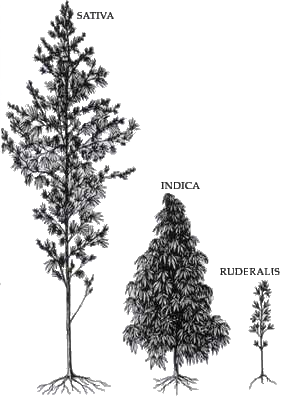
Types of cannabis
CBD is a 5-HT1A receptor agonist, which may also contribute to an anxiolytic effect.[157] This likely means the high concentrations of CBD found in Cannabis indica mitigate the anxiogenic effect of THC significantly.[157] The cannabis industry claims that sativa strains provide a more stimulating psychoactive high while indica strains are more sedating with a body high.[158] However this is disputed by researchers.[159]
Psychoactive ingredients
According to the United Nations Office on Drugs and Crime (UNODC), "the amount of THC present in a cannabis sample is generally used as a measure of cannabis potency."[160] The three main forms of cannabis products are the flower/fruit, resin (hashish), and oil (hash oil). The UNODC states that cannabis often contains 5% THC content, resin "can contain up to 20% THC content", and that "Cannabis oil may contain more than 60% THC content."[160]
A 2012 review found that the THC content in marijuana had increased worldwide from 1970 to 2009.[161] It is unclear, however, whether the increase in THC content has caused people to consume more THC or if users adjust based on the potency of the cannabis.
It is likely that the higher THC content allows people to ingest less tar.
At the same time, CBD levels in seized samples have lowered, in part because of the desire to produce higher THC levels and because more illegal growers cultivate indoors using artificial lights.
This helps avoid detection but reduces the CBD production of the plant.[162]
Australia's National Cannabis Prevention and Information Centre (NCPIC) states that the buds (infructescences) of the female cannabis plant contain the highest concentration of THC, followed by the leaves. The stalks and seeds have "much lower THC levels".[163] The UN states that leaves can contain ten times less THC than the buds, and the stalks one hundred times less THC.[160]
After revisions to cannabis scheduling in the UK, the government moved cannabis back from a class C to a class B drug. A purported reason was the appearance of high potency cannabis. They believe skunk accounts for between 70 and 80% of samples seized by police[164] (despite the fact that skunk can sometimes be incorrectly mistaken for all types of herbal cannabis).[165][166] Extracts such as hashish and hash oil typically contain more THC than high potency cannabis infructescences.[167]
Preparations
Marijuana
Marijuana or marihuana (herbal cannabis),[23] consists of the dried flowers and fruits and subtending leaves and stems of the female Cannabis plant.[168][169][170][171] This is the most widely consumed form,[171] containing 3% to 20% THC,[172] with reports of up-to 33% THC.[173] This is the stock material from which all other preparations are derived. Although herbal cannabis and industrial hemp derive from the same species and contain the psychoactive component (THC), they are distinct strains with unique biochemical compositions and uses. Hemp has lower concentrations of THC and higher concentrations of CBD, which decreases the psychoactive effects[174][175]
Kief
Hashish
Hashish (also spelled hasheesh, hashisha, or simply hash) is a concentrated resin cake or ball produced from pressed kief, the detached trichomes and fine material that falls off cannabis fruits, flowers and leaves.[179] or from scraping the resin from the surface of the plants and rolling it into balls. It varies in color from black to golden brown depending upon purity and variety of cultivar it was obtained from.[180] It can be consumed orally or smoked, and is also vaporized, or 'vaped'.[181] The term "rosin hash" refers to a high quality solventless product obtained through heat and pressure.[182]
Tincture
Hash oil
Hash oil is a resinous matrix of cannabinoids obtained from the Cannabis plant by solvent extraction,[185] formed into a hardened or viscous mass.[186] Hash oil can be the most potent of the main cannabis products because of its high level of psychoactive compound per its volume, which can vary depending on the plant's mix of essential oils and psychoactive compounds.[187] Butane and supercritical carbon dioxide hash oil have become popular in recent years.[188]
Infusions
There are many varieties of cannabis infusions owing to the variety of non-volatile solvents used.[189] The plant material is mixed with the solvent and then pressed and filtered to express the oils of the plant into the solvent.
Examples of solvents used in this process are cocoa butter, dairy butter, cooking oil, glycerine, and skin moisturizers. Depending on the solvent, these may be used in cannabis foods or applied topically.[190]
Medical use

Cannabis sativa from Vienna Dioscurides, c. 512 CE
Medical marijuana refers to the use of the Cannabis plant as a physician-recommended herbal therapy as well as synthetic[191] THC and cannabinoids. So far, the medical use of cannabis is legal only in a limited number of territories, including Canada,[68] Belgium, Australia, the Netherlands, Spain, and many U.S. states. This usage generally requires a prescription, and distribution is usually done within a framework defined by local laws. There is evidence supporting the use of cannabis or its derivatives in the treatment of chemotherapy-induced nausea and vomiting, neuropathic pain, and multiple sclerosis. Lower levels of evidence support its use for AIDS wasting syndrome, epilepsy, rheumatoid arthritis, and glaucoma.[80]
History
Ancient history
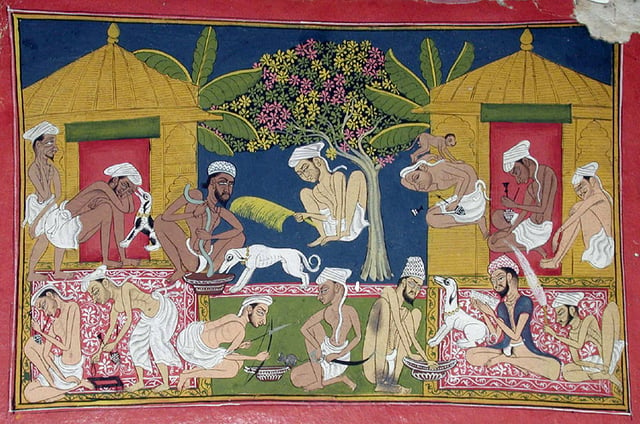
Hindus eating bhang (c. 1790)
Cannabis is indigenous to Central Asia[192] and the Indian subcontinent,[193] and its uses for fabric and rope dates back to the Neolithic age in China and Japan.[194][195] It is unclear when cannabis first became known for its psychoactive properties; some research suggests that the ancient Indian drug soma, mentioned in the Vedas, sometimes contained cannabis. This is based on the discovery of a basin containing cannabis in a shrine of the second millennium BC in Turkmenistan.[196]
Cannabis was known to the ancient Assyrians, who discovered its psychoactive properties through the Iranians.[197] Using it in some religious ceremonies, they called it qunubu (meaning "way to produce smoke"), a probable origin of the modern word "cannabis".[198] The Iranians also introduced cannabis to the Scythians, Thracians and Dacians, whose shamans (the kapnobatai—"those who walk on smoke/clouds") burned cannabis infructescences to induce trance.[199] in food and drink]], including [192][201]
Cannabis has an ancient history of ritual use and is found in pharmacological cults around the world. The earliest evidence of cannabis smoking has been found in the 2,500-year-old tombs of Jirzankal Cemetery in the Pamir Mountains in Western China, where cannabis residue were found in burners with charred pebbles possibly used during funeral rituals.[202][38] Hemp seeds discovered by archaeologists at Pazyryk suggest early ceremonial practices like eating by the Scythians occurred during the 5th to 2nd century BC, confirming previous historical reports by Herodotus.[203]Marijuana%2C%20America's%20New%20Drug%20P]] [205]
Modern history

Cannabis propaganda from 1935
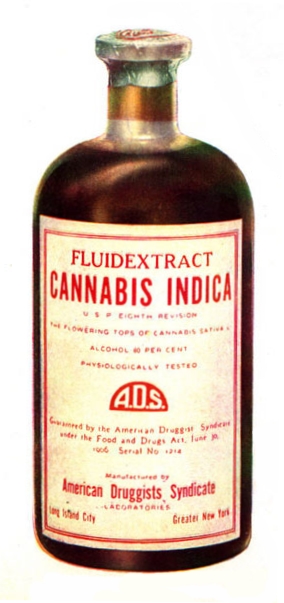
Cannabis indica fluid extract, American Druggists Syndicate (pre-1937)
Following an 1836–1840 travel in North Africa and the Middle East, French physician Jacques-Joseph Moreau wrote on the psychological effects of cannabis use; he was a member of Paris' Club des Hashischins. In 1842, Irish physician William Brooke O'Shaughnessy, who had studied the drug while working as a medical officer in Bengal with the East India company, brought a quantity of cannabis with him on his return to Britain, provoking renewed interest in the West.[206] Examples of classic literature of the period featuring cannabis include Les paradis artificiels (1860) by Charles Baudelaire and The Hasheesh Eater (1857) by Fitz Hugh Ludlow.
Cannabis was criminalized in various countries beginning in the 19th century.
The British colonies of Mauritius banned cannabis in 1840 over concerns on its effect on Indian indentured workers;[207] the same occurred in British Singapore in 1870.[208] In the United States, the first restrictions on sale of cannabis came in 1906 (in District of Columbia).[209] Canada criminalized cannabis in The Opium and Narcotic Drug Act, 1923,[210] before any reports of the use of the drug in Canada, but eventually legalized its consumption for recreational and medicinal purposes in 2018.[68]
In 1925, a compromise was made at an international conference in The Hague about the International Opium Convention that banned exportation of "Indian hemp" to countries that had prohibited its use, and requiring importing countries to issue certificates approving the importation and stating that the shipment was required "exclusively for medical or scientific purposes". It also required parties to "exercise an effective control of such a nature as to prevent the illicit international traffic in Indian hemp and especially in the resin".[211][212] In the United States in 1937, the Marihuana Tax Act was passed,[213] and prohibited the production of hemp in addition to cannabis.
In 1972, the Dutch government divided drugs into more- and less-dangerous categories, with cannabis being in the lesser category.
Accordingly, possession of 30 grams (1.1 oz) or less was made a misdemeanor.[214] Cannabis has been available for recreational use in coffee shops since 1976.[215] Cannabis products are only sold openly in certain local "coffeeshops" and possession of up to 5 grams (0.18 oz) for personal use is decriminalized, however: the police may still confiscate it, which often happens in car checks near the border. Other types of sales and transportation are not permitted, although the general approach toward cannabis was lenient even before official decriminalization.[216][217][218]
In Uruguay, President Jose Mujica signed legislation to legalize recreational cannabis in December 2013, making Uruguay the first country in the modern era to legalize cannabis. In August 2014, Uruguay legalized growing up to six plants at home, as well as the formation of growing clubs, and a state-controlled marijuana dispensary regime.
As of October 17, 2018 when recreational use of cannabis was legalized in Canada, dietary supplements for human use and veterinary health products containing not more than 10 parts per million of THC extract were approved for marketing; Nabiximols (as Sativex) is used as a prescription drug in Canada.[68]
Society and culture
Legal status

Legal status of cannabis possession for non-medical use Legal Illegal but decriminalized Illegal but often unenforced Illegal See also countries that have legalized medical use of cannabis
Since the beginning of the 20th century, most countries have enacted laws against the cultivation, possession or transfer of cannabis.[221] These laws have impacted adversely on cannabis cultivation for non-recreational purposes, but there are many regions where handling of cannabis is legal or licensed. Many jurisdictions have lessened the penalties for possession of small quantities of cannabis so that it is punished by confiscation and sometimes a fine, rather than imprisonment, focusing more on those who traffic the drug on the black market.
In some areas where cannabis use had been historically tolerated, new restrictions were instituted, such as the closing of cannabis coffee shops near the borders of the Netherlands,[222] and closing of coffee shops near secondary schools in the Netherlands.[223] In Copenhagen, Denmark in 2014, mayor Frank Jensen discussed possibilities for the city to legalize cannabis production and commerce.[224]
Some jurisdictions use free voluntary treatment programs and/or mandatory treatment programs for frequent known users.
Simple possession can carry long prison terms in some countries, particularly in East Asia, where the sale of cannabis may lead to a sentence of life in prison or even execution.
Political parties, non-profit organizations, and causes based on the legalization of medical cannabis and/or legalizing the plant entirely (with some restrictions) have emerged in such countries as China and Thailand.[225][226]
In December 2012, the U.S. state of Washington became the first state to officially legalize cannabis in a state law (Washington Initiative 502) (but still illegal by federal law),[227] with the state of Colorado following close behind (Colorado Amendment 64).[228] On January 1, 2013, the first marijuana "club" for private marijuana smoking (no buying or selling, however) was allowed for the first time in Colorado.[229] The California Supreme Court decided in May 2013 that local governments can ban medical marijuana dispensaries despite a state law in California that permits the use of cannabis for medical purposes. At least 180 cities across California have enacted bans in recent years.[230]
In December 2013, Uruguay became the first country to legalize growing, sale and use of cannabis.[231] After a long delay in implementing the retail component of the law, in 2017 sixteen pharmacies were authorized to sell cannabis commercially.[232] On June 19, 2018, the Canadian Senate passed a bill and the Prime Minister announced the effective legalization date as October 17, 2018.[68][233] Canada is the second nation to legalize the drug.[234]
In November 2015, Uttarakhand became the first state of India to legalize the cultivation of hemp for industrial purposes.[235] Usage within the Hindu and Buddhist cultures of the Indian subcontinent is common, with many street vendors in India openly selling products infused with cannabis, and traditional medical practitioners in Sri Lanka selling products infused with cannabis for recreational purposes and well as for religious celebrations.[236] It was criminalized in the Indian subcontinent by the Dutch and then the British. India and Sri Lanka have allowed cannabis to be taken in the context of traditional culture for recreational/celebratory purposes and also for medicinal purposes.[236]
On October 17, 2015, Australian health minister Sussan Ley presented a new law that will allow the cultivation of cannabis for scientific research and medical trials on patients.[237]
On October 17, 2018, Canada legalized cannabis for recreational adult use[238] making it the second country in the world to do so after Uruguay and the first G7 nation.[234] The Canadian Licensed Producer system aims to become the Gold Standard in the world for safe and secure cannabis production,[240] including provisions for a robust craft cannabis industry where many expect opportunities for experimenting with different strains.[241] Laws around use vary from province to province including age limits, retail structure, and growing at home.[238]
As the drug has increasingly been seen as a health issue instead of criminal behavior, marijuana has also been legalized or decriminalized in: Czech Republic,[242] Colombia,[243][244] Ecuador,[245][246][247] Portugal,[248] South Africa[249] and Canada.[68] Medical marijuana was legalized in Mexico in mid-2017; legislators plan to legalize its recreational use by late 2019.[250][251][252]
Usage
| Substance | Bestestimate | Lowestimate | Highestimate |
|---|---|---|---|
| Amphetamine- type stimulants | 34.16 | 13.42 | 55.24 |
| Cannabis | 192.15 | 165.76 | 234.06 |
| Cocaine | 18.20 | 13.87 | 22.85 |
| Ecstasy | 20.57 | 8.99 | 32.34 |
| Opiates | 19.38 | 13.80 | 26.15 |
| Opioids | 34.26 | 27.01 | 44.54 |
United States
In 2015, almost half of the people in the United States had tried marijuana, 12% had used it in the past year, and 7.3% had used it in the past month.[36] In 2014, daily marijuana use amongst US college students had reached its highest level since records began in 1980, rising from 3.5% in 2007 to 5.9% in 2014 and had surpassed daily cigarette use.[256]
Marijuana use in the United States is three times above the global average, but in line with other Western democracies.
Forty-four percent of American 12th graders have tried the drug at least once, and the typical age of first-use is 16, similar to the typical age of first-use for alcohol but lower than the first-use age for other illicit drugs.[254]
Economics
Production
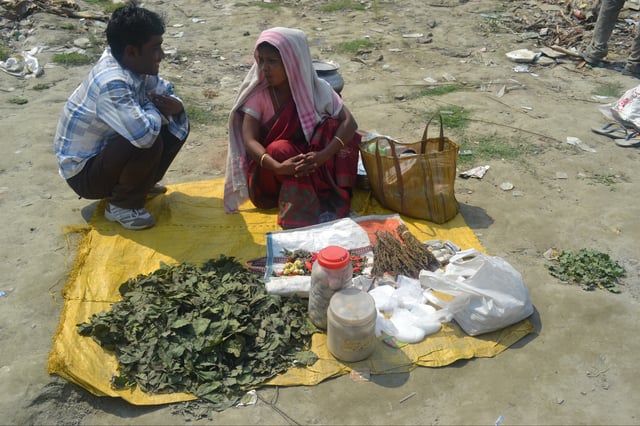
Woman selling cannabis and bhang in Guwahati, Assam, India
Sinsemilla (Spanish for "without seed") is the dried, seedless (i.e parthenocarpic) infructescences of female cannabis plants. Because THC production drops off once pollination occurs, the male plants (which produce little THC themselves) are eliminated before they shed pollen to prevent pollination, thus inducing the development of parthenocarpic fruits gathered in dense infructescences. Advanced cultivation techniques such as hydroponics, cloning, high-intensity artificial lighting, and the sea of green method are frequently employed as a response (in part) to prohibition enforcement efforts that make outdoor cultivation more risky.
"Skunk" refers to several named strains of potent cannabis, grown through selective breeding and sometimes hydroponics. It is a cross-breed of Cannabis sativa and C. indica (although other strains of this mix exist in abundance). Skunk cannabis potency ranges usually from 6% to 15% and rarely as high as 20%. The average THC level in coffee shops in the Netherlands is about 18–19%.[258]
The average levels of THC in cannabis sold in the United States rose dramatically between the 1970s and 2000.[259] This is disputed for various reasons, and there is little consensus as to whether this is a fact or an artifact of poor testing methodologies.[259] According to Daniel Forbes writing for slate.com, the relative strength of modern strains are likely skewed because undue weight is given to much more expensive and potent, but less prevalent, samples.[260] Some suggest that results are skewed by older testing methods that included low-THC-content plant material such as leaves in the samples, which are excluded in contemporary tests. Others believe that modern strains actually are significantly more potent than older ones.[259]
Price
The price or street value of cannabis varies widely depending on geographic area and potency.[261] Prices and overall markets have also varied considerably over time.
In 1997, cannabis was estimated to be overall the number four value crop in the US, and number one or two in many states, including California, New York, and Florida.
This estimate is based on a value to growers of ~60% of retail value, or $3,000 per pound ($6,600/kg).[262]
In 2006, cannabis was estimated to have been a $36 billion market.[263] This estimate has been challenged as exaggerated.[254] The UN World Drug Report (2008) estimated that 2006 street prices in the US and Canada ranged from about US$8.8 to $25 per gram (approximately $250 to $700 per ounce), depending on quality.[264] Typical U.S. retail prices were $10–15 per gram (approximately $280–420 per ounce).
In 2017, the U.S. was estimated to constitute 90% of the worldwide $9.5 billion trade in cannabis.[265]
After some U.S. states legalized cannabis, street prices began to drop.
In Colorado, the price of smokable buds (infructescences) dropped 40 percent between 2014 and 2019, from $200 per ounce to $120 per ounce ($7 per gram to $4.19 per gram).[266]
The European Monitoring Centre for Drugs and Drug Addiction reports that typical retail prices in Europe for cannabis varied from €2 to €20 per gram in 2008, with a majority of European countries reporting prices in the range €4–10.[267]
Gateway drug
The Gateway Hypothesis states that cannabis use increases the probability of trying "harder" drugs.
The hypothesis has been hotly debated as it is regarded by some as the primary rationale for the United States prohibition on cannabis use.[268][269] A Pew Research Center poll found that political opposition to marijuana use was significantly associated with concerns about health effects and whether legalization would increase marijuana use by children.[270]
Some studies state that while there is no proof for the gateway hypothesis,[271] young cannabis users should still be considered as a risk group for intervention programs.[272] Other findings indicate that hard drug users are likely to be poly-drug users, and that interventions must address the use of multiple drugs instead of a single hard drug.[273] Almost two-thirds of the poly drug users in the 2009-2010 Scottish Crime and Justice Survey used cannabis.[274]
The gateway effect may appear due to social factors involved in using any illegal drug.
Because of the illegal status of cannabis, its consumers are likely to find themselves in situations allowing them to acquaint with individuals using or selling other illegal drugs.[275][276] Studies have shown that alcohol and tobacco may additionally be regarded as gateway drugs;[277] however, a more parsimonious explanation could be that cannabis is simply more readily available (and at an earlier age) than illegal hard drugs. In turn, alcohol and tobacco are typically easier to obtain at an earlier age than is cannabis (though the reverse may be true in some areas), thus leading to the "gateway sequence" in those individuals, since they are most likely to experiment with any drug offered.[268]
A related alternative to the gateway hypothesis is the common liability to addiction (CLA) theory.
It states that some individuals are, for various reasons, willing to try multiple recreational substances.
The "gateway" drugs are merely those that are (usually) available at an earlier age than the harder drugs.
Researchers have noted in an extensive review that it is dangerous to present the sequence of events described in gateway "theory" in causative terms as this hinders both research and intervention.[278]
Research
There are also other difficulties in researching the effects of cannabis.
Many people who smoke cannabis also smoke tobacco.[284] This causes confounding factors, where questions arise as to whether the tobacco, the cannabis, or both that have caused a cancer.
Another difficulty researchers have is in recruiting people who smoke cannabis into studies.
Because cannabis is an illegal drug in many countries, people may be reluctant to take part in research, and if they do agree to take part, they may not say how much cannabis they actually smoke.[285]
A 2015 review found that the use of high CBD-to-THC strains of cannabis showed significantly fewer positive symptoms such as delusions and hallucinations, better cognitive function and both lower risk for developing psychosis, as well as a later age of onset of the illness, compared to cannabis with low CBD-to-THC ratios.[286] A 2014 Cochrane review found that research was insufficient to determine the safety and efficacy to using cannabis to treat schizophrenia or psychosis.[287] As of 2017, the molecular mechanisms for the anti-inflammatory and possible pain relieving effects of cannabis are under preliminary research.[288]
By country
Uruguay and Canada are the only countries that have fully legalized the consumption and sale of recreational cannabis nationwide.[289][234] In the United States, 11 states and the District of Columbia have legalized the recreational use of cannabis – though the drug remains illegal at the federal level.[42] Laws vary from state to state when it comes to the commercial sale. Court rulings in Georgia and South Africa have led to the legalization of cannabis consumption, but not legal sales. A policy of limited enforcement has also been adopted in many countries, in particular Spain and the Netherlands where the sale of cannabis is tolerated at licensed establishments.[291][292]
See also
Occupational health concerns of cannabis use
